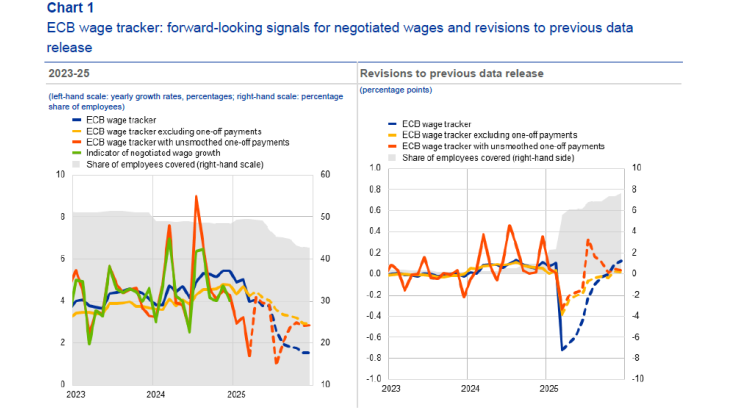- Accueil
- Communiqués de presse
- New data release: ECB wage tracker conti...
New data release: ECB wage tracker continues to indicate that negotiated wage pressures will ease over the course of the year
- ECB wage tracker updated with agreements signed up to first week of April 2025
- Forward-looking information suggests negotiated wage pressures will ease overall in 2025, consistent with data published following March Governing Council meeting
Mise en ligne le 23 Avril 2025
The European Central Bank wage tracker, which covers active collective bargaining agreements, indicates negotiated wage growth with smoothed one-off payments of 4.8% in 2024 (based on an average coverage of 48.8% of employees in participating countries), and 3.1% in 2025 (based on an average coverage of 46.5%). The ECB wage tracker with unsmoothed one-off payments indicates average negotiated wage growth level of 4.9% in 2024 and 2.8% in 2025. The steeply downward trend of the forward-looking wage tracker in 2025 partly reflects the mechanical impact of large one-off payments (that were paid in 2024 but drop out in 2025) and the frontloaded nature of wage increases in some sectors in 2024. The wage tracker excluding one-off payments indicates growth of 4.2% in 2024 and 3.8% in 2025. See Chart 1 and Table 1 for further details.
The ECB wage tracker may be subject to revisions, and the forward-looking part should not be interpreted as a forecast as it only captures information in active collective bargaining agreements. For a more comprehensive assessment of wage developments in the euro area, please refer to the March 2025 ECB staff macroeconomic projections for the euro area, which indicate a yearly growth rate of compensation per employee in the euro area of 4.6% in 2024 and 3.4% in 2025, with a quarterly profile for 2025 of 3.8% in the first quarter, 3.7% in the second quarter, 3.4% in the third quarter and 2.8% in the fourth quarter.
The ECB publishes four wage tracker indicators for the aggregate of seven participating euro area countries via the ECB Data Portal.

Notes: Dashed lines denote forward-looking information up to December 2025.
Download the full publication
Mise à jour le 25 Avril 2025